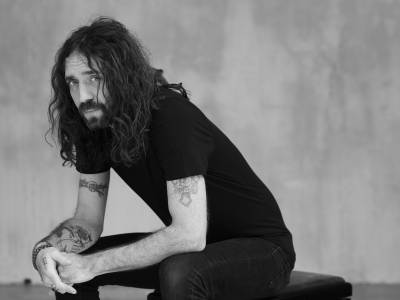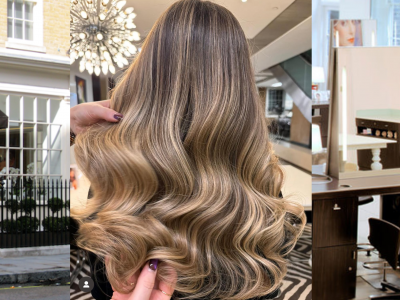With the adept brushstrokes of an Old Master, the irreverent mark of a Pop Modernist, the probing photographic eye of a hyperrealist and the grit of a street-smart survivor, rising Scottish contemporary artist Ross Muir is in a unique league of his own. Muir only first picked up a set of paints and brushes aged 30. His star has rapidly ascended like a skyrocket across the global art scene; so much so that when 13 of his works were presented by London’s prestigious Maddox gallery last year — under the guidance of European gallery director Fi Lovett — they sold instantly.
Muir found painting a much-needed salve that not only eased the heartbreak and anger he’d felt so deeply, for so long, after the loss of his mother when he was 15 — and consequent lost years struggling with drug addiction — but also quelled the further sadness of losing his ever-supportive father in 2013. In the beginning, “I didn’t know what I was painting,” he says. “My ideas often outweighed my ability, so to learn I tried copying other artists.” Muir looked to artists such as Picasso, Magritte, Rembrandt and Vermeer for insight into technique, proportion and form. “A lot of things in my life have been easy come, easy go. I was always good at stuff — maybe never the best, but I was always right up there, and things just came naturally to me. But with painting, it was more challenging,” he reflects.
His talent developed quickly, however, and he felt bad about copying other artists’ work. Muir turned instead to the internet and magazines to source images of people’s faces in order to practise his figurative painting. “At first they were so bad, they didn’t look anything like what I was trying to copy, but slowly and surely, they were getting very close,” he says. He went one step further by setting up his own shoots, hiring a model, photographer and hair and make-up artist to help create different scenarios for him to paint.
“With what I was getting for a painting back then, it was uneconomical, but at least it was my own,” he says. It was while working on his own self-portrait, channeling the influence of another favourite artist, the Scottish painter John Byrne, that Muir established the underlying narrative that marks much of his work today. Sporting a classic Adidas tracksuit top as he painted, Muir was drawn to the way he had captured the folds in the sleeve — especially as “the texture of the material, with the light and the three stripes, had been hard to paint, pushing the boundary of my skills.”
Muir decided to explore the concept further. “I had the idea to do an Old Masters painting — Vermeer’s Girl with a Pearl Earring — but shoot it with a model wearing a black Adidas top,” he explains. The painting proved a struggle. “I had hit a brick wall, stuck in traffic, because I just couldn’t do the hand,” he remembers. However, rather than abandoning the idea entirely, through sheer happenstance the following day Muir spotted the Adidas top lying near a van Gogh calendar.
Having just watched the film Love Vincent (depicted entirely in oil-painted animation), he gave it another go. The result was Muir’s now seminal Square Gogh, with van Gogh depicted wearing the tracksuit top and painted perfectly in the style of the famous Dutch artist’s bold, dramatic post-Impressionist brush strokes. It struck such a chord with the viewing public, going viral in 2018, that Muir ran it off as a large-format open print and it has sold in the thousands
The Adidas top has gone on to feature regularly in Muir’s work, from paintings such as Matiddas, 2018 (in the style of Matisse’s Blue Nude II, 1952), Green Lady with Red Top, 2020 (borrowing from Tretchikoff’s 1952 painting Chinese Girl) and the John Singer Sargent-inspired Green Bow, 2021, to recent pieces such as Driven, 2022 (reflecting Roy Lichtenstein’s In the Car, 1963) and Wee Boy, 2022 (after van Gogh’s Portrait of Camille Roulin, 1888).
That the Adidas tracksuit — as well as other contemporary motifs he uses, including trainers, fluffy dice, Gucci T-shirts and horse-bit loafers, Staedtler pencils and tattooed fingers — should lend Muir’s work added cultural or political gravitas has been “purely innocent,” he asserts. “When I first started, I didn’t know what appropriation art was, I didn’t even know what parody was,” he laughs. “I never thought ‘I’ll put this or that in and this is what’s going to happen’.”
His work has rapidly gone viral in the past four years across social media platforms such as Instagram — especially after Muir’s transformation of Square Gogh into a poster with the words Jist Gogh Hame (Just Go Home, said in the artist’s native Glaswegian drawl), which was put up around Glasgow to urge people to stay home during the pandemic, was reposted by the Van Gogh Museum in Amsterdam. He now appreciates that for some, his paintings have come to “bridge a gap,” he says. Indeed, one secondary school teacher said she was using images of his work to help pupils connect both with art and wider issues such as social mobility. “The addition of trainers, stripes and earphones has made your artwork unique but also accessible, especially to working-class children,” she said.
Most of Muir’s works start as sketches, either on paper or marked in white pastel pencil directly onto a black canvas, a technique inspired by Leonardo da Vinci quote: “A painter should begin every canvas with a wash of black, because all things in nature are dark except where exposed by the light.” It’s why his portraits shine, he suggests, “because there are so many layers of colour on there to take the black away.” Some pieces can take up to 100 hours to paint, like Tiga Tiga, 2022, which reimagines Henri Rousseau’s Traumgarten and cheekily features John Lennon’s bespectacled face as the lion hiding in the foliage.
In his latest collection, Muir pays homage to artists such as Jean-Michel Basquiat, Frida Kahlo, Henry Raeburn and Ernst Deger. In Remburnt, 2022, the painting not only cleverly riffs on the style of Carel Fabritius’s The Goldfinch, 1654, which Muir has surrounded with graffiti scrawl, but also nods to his love of Rembrandt, and the way the great 17th-century artist captured light in his work. There are odes to iconic 20th-century posters, such as Bernard Villemot’s Bally Kick, which Muir has recreated as Ballz Up, 2022, with the woman coquettishly kicking a football in the air wearing Adidas trainers instead of Bally heels.
While Muir’s paintings are visually joyful and charmingly insouciant, “it’s a serious business painting them, and they mean the world to me,” he says. It has also offered Muir “a sense of redemption,” he explains. “I’m not great at communicating my views but the paintings have given me a voice without having to say that much, and they’ve helped integrate me back into society. Loads of amazing things have happened because of them. I’m so grateful.”
“My best days are when I’ve been really present, not had any meltdowns, and I’ve done an honest day’s painting — possibly overcoming something that’s been lying around for a while and making progress with that,” he says. And while he’s naturally pleased people have connected so passionately with his paintings, it’s not the driving force behind his pieces. “I don’t want to be too precious about projecting what they mean — I don’t want to be spoiling somebody else’s opinion, that’s their business — but I do hope they enjoy them and get something from them, as much as I have.”
Originally published in Sphere Magazine, in partnership with Maddox Gallery.
Ross Muir joined Maddox’s roster of talented artists in January 2021 and the gallery will hold a solo exhibition of his work in May this year. maddoxgallery.com






